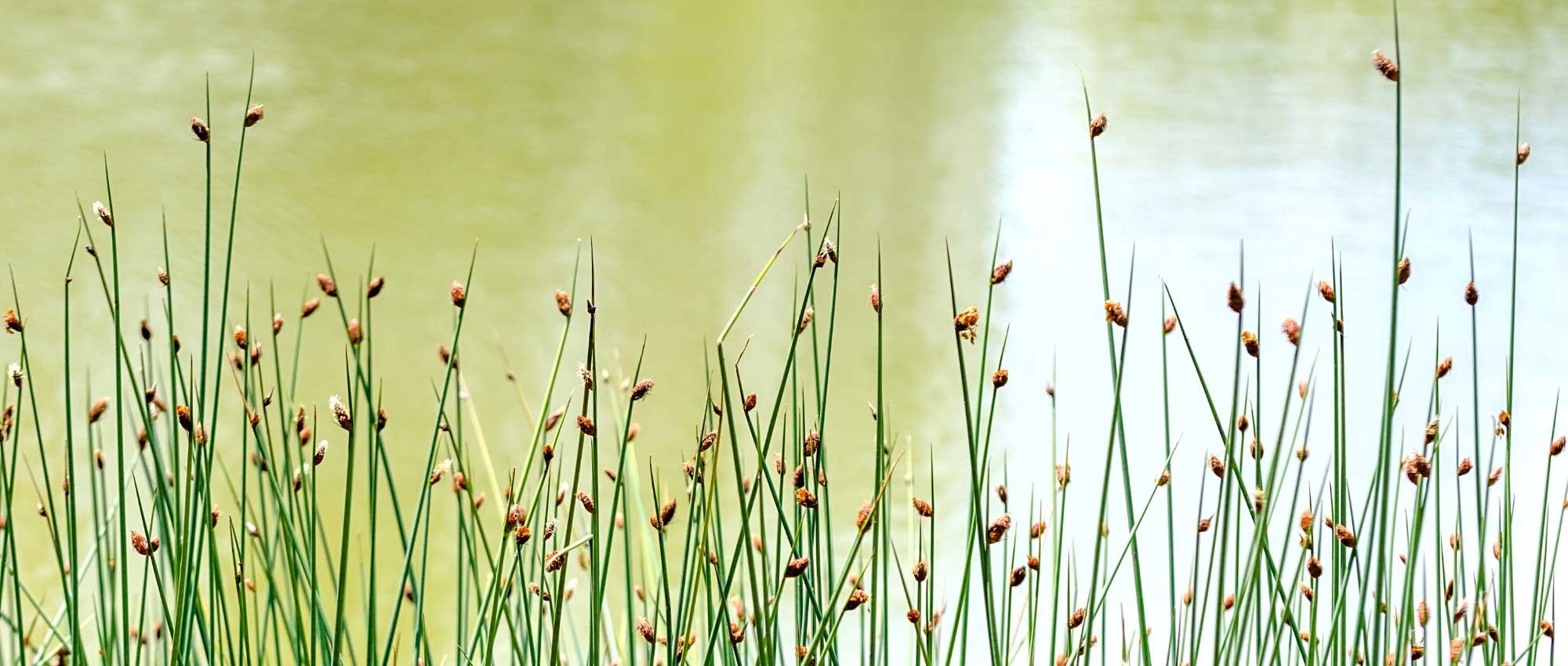
Scirpus: Planting, Growing and Caring
Contents
The Scirpus in a nutshell
- Scirpus are very attractive marginal plants, typically featuring slender, upright stems.
- They can add significant verticality and graphic appeal to the edge of a pond.
- They help stabilise the banks and purify the water.
- Some varieties stand out due to their variegated stems, which are very bright.
- Scirpus cernuus adapts well to container cultivation, provided the substrate remains moist.
The word from our expert
Scirpus are stunning perennial plants from the papyrus and sedge family (Cyperaceae) and are perfect for embellishing the edges of a pond. Their slender, highly graphic stems are particularly admired, which can have a flexible, trailing habit, as seen in Scirpus cernuus, or a stiff, upright habit, like Scirpus lacustris. Some varieties, such as Scirpus lacustris ‘Albescens’ or Scirpus tabernaemontani ‘Zebrinus’, feature stems variegated with creamy white to pale yellow, making them exceptionally bright! Scirpus typically flower in summer, producing brown spikelets at the tips of their stems.
Scirpus are ideal plants for naturalising a pond, bringing both a natural and graphic style! Depending on the species, they thrive either on the pond edges or fully submerged in the water. They prefer full sun but also tolerate partial shade. Beyond their ornamental appeal, scirpus help stabilise pond edges and purify the water. The Scirpus cernuus can also be grown in pots, on a terrace or indoors, as long as the substrate remains consistently moist.
botany
Botanical data
- Latin name Scirpus sp.
- Family Cyperaceae
- Common name bulrush, club-rush
- Flowering generally between June and August
- Height highly variable, between 20 cm and 2 m
- Sun exposure full sun
- Soil type moist, rich, even clayey
- Hardiness between –8°C (Scirpus cernuus) and –20°C depending on the species
Bulrushes comprise around 110 species of perennial plants with long, slender stems, resembling grasses or, more often, rushes. Some grow wild in France, typically in wetlands, along watercourses, on riverbanks, or in marshes. They play an ecological role by helping to stabilise and reinforce riverbanks, thus combating erosion, and serving as a refuge for fish and amphibians. They are relatively unknown, and only a few of them are cultivated in gardens.
Bulrushes are fairly hardy plants; most can withstand temperatures as low as –20°C, except for Scirpus cernuus, which cannot tolerate temperatures below –8°C. Therefore, unless you live in the mild climates of the Mediterranean basin or the Atlantic coast, it’s best to protect it during winter.
Bulrushes belong to the Cyperaceae family, which includes around 5,000 species. This is the family of papyrus (Cyperus papyrus), sedges, and cotton grasses (Eriophorum). The Scirpus genus is very close to the Schoenoplectus genus, with which some bulrushes have been reclassified. For example, the species Schoenoplectus lacustris and Schoenoplectus tabernaemontani are synonymous with Scirpus lacustris and Scirpus tabernaemontani.
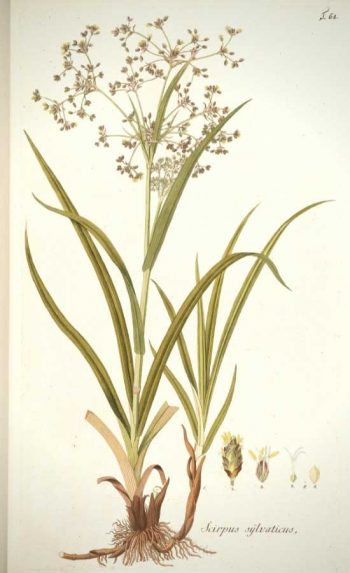
Scirpus sylvaticus: Botanical illustration
Scirpus cernuus is commonly nicknamed the Drooping Club-rush, as its foliage gracefully trails towards the ground. This is also the translation of its species name, from the Latin cernua: “drooping” or “nodding.” In English, it is nicknamed Fiber Optic Grass due to its numerous thread-like stems, tipped with small silvery inflorescences that strikingly resemble strands of fibre-optic cable. Scirpus lacustris, on the other hand, is nicknamed the Common Club-rush or Basket Rush, as its long stems were historically used for chair caning and barrel-making. Moreover, it’s true that bulrushes closely resemble rushes, which, like them, bear long stems and thrive in wet environments. However, they do not belong to the same botanical family.
Bulrushes form dense clumps of long, slender stems, which are particularly striking. Some species, such as Scirpus lacustris and Scirpus tabernaemontani, are rhizomatous and spread over time, potentially forming large colonies. The height of bulrushes varies greatly: the Scirpus cernuus does not exceed 30 cm in height and has trailing stems, while the Scirpus lacustris and the Scirpus tabernaemontani produce stiff stems that can reach up to 1.50 m, or even 2 m in height. You can rely on these latter species to add vertical interest to the edges of a pond.
Bulrushes generally flower in summer, between June and August, bearing brown spikelets at the tips of their stems, except for the Scirpus cernuus, which blooms almost year-round and produces tiny cream-white spikelets.
The inflorescences, terminal or axillary, consist of countless spikelets (between 50 and 500!) measuring less than 4 mm in diameter, each composed of minuscule flowers. The perianth—petals and sepals—is reduced to small bristles (3 to 6 per flower). The flowers are bisexual: each has 1 to 3 stamens (male reproductive parts, releasing pollen) and a style (female reproductive part, receiving pollen). Pollination is wind-driven: the wind carries pollen to the style of another flower (anemogamous pollination). This explains why bulrush flowers are neither fragrant nor colourful, as these traits aim to attract insects for pollination. You will therefore never see insects visiting bulrush flowers.

The spikelets of bulrushes, more or less branched depending on the species. From left to right: Scirpus cernuus, Scirpus lacustris, Scirpus tabernaemontani, and Scirpus sylvaticus (photos: Krzysztof Ziarnek / AnRo0002 / R. A. Nonenmacher / Robert Flogaus-Faust)
Scirpus cernuus, S. lacustris, and S. tabernaemontani have very short, almost non-existent leaves, reduced to foliar sheaths. Only their stems are visible and decorative. However, some bulrushes do have true leaves: for example, the Wood Club-rush (Scirpus sylvaticus) bears long, slender leaves resembling those of grasses.
The Scirpus tabernaemontani ‘Zebrinus’ stands out for its variegated stems, green striped with yellow, giving it a highly original appearance. As for the Scirpus lacustris ‘Albescens’, it features very pale, cream-yellow stems. These varieties are ideal for bringing brightness to a water garden!
The fruits of bulrushes are tiny trigonous or convex achenes, brown in colour, measuring 0.5 to 2 mm. Each achene contains a seed.

The foliage of Scirpus sylvaticus and the decorative stems of Scirpus cernuus, Scirpus tabernaemontani ‘Zebrinus’, and Scirpus lacustris ‘Albescens’ (photos: Roland.aprent / Jerzy Opioła / Krzysztof Ziarnek / David J. Stang)
The main varieties of Scirpus
The Most Popular Varieties
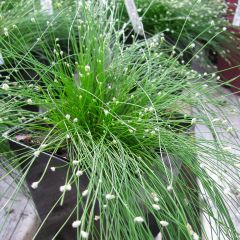
Scirpus cernuus - Fibre Optic Grass
- Flowering time March to December
- Height at maturity 30 cm
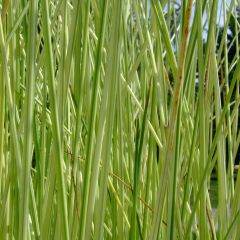
Schoenoplectus lacustris subsp. tabernaemontani Albescens
- Flowering time July to October
- Height at maturity 1,20 m

Schoenoplectus lacustris subsp tabernaemontani Zebrinus
- Flowering time July to September
- Height at maturity 1,20 m
Discover other Scirpus
View all →Available in 1 sizes
Available in 1 sizes
Available in 2 sizes
Planting
Where to Plant?
Scirpus plants thrive in full sun, as long as the soil remains moist, but they will also tolerate partial shade. If possible, place them in a sheltered spot to protect them from wind, which can break the stems of taller species like Scirpus lacustris.
These plants are ideal for aquatic gardens and for naturalising ponds. Scirpus lacustris and Scirpus tabernaemontani must be submerged, with their roots in water: plant them at a depth of 20 to 30 cm. Scirpus cernuus, on the other hand, can be planted under a few centimetres of water, partially submerged, but will also thrive in simply moist soil, making it suitable for planting outside the water, on the banks. It has the added advantage of adapting well to pot cultivation and can be grown indoors, for example in a conservatory or a well-lit room. As its stems droop towards the ground, growing it in a hanging basket can really showcase its beauty.
Scirpus plants are purifying plants, helping to oxygenate and clean the water. You can pair them with other plants used in phytoremediation, such as reeds, yellow flag irises (Iris pseudacorus), water mint, Acorus calamus, or broadleaf cattail (Typha latifolia)…
Discover our advice sheet “8 Oxygenating Aquatic Plants for Ponds or Marshes”.
When to Plant?
Plant Scirpus in spring, around April, or in autumn, in September-October. For Scirpus cernuus, prefer spring planting so it can benefit from mild temperatures to establish itself, as it is less hardy than other species. In any case, avoid periods of frost or extreme heat.
How to Plant?
In a pond:
When you purchase Scirpus plants, plant them promptly or store them in a basin of water in the meantime to prevent the root ball from drying out.
- Before placing it in the pond, we recommend planting the Scirpus in a perforated plastic basket, designed for aquatic plants, to facilitate its establishment and control its spread.
- Line the bottom and sides of the basket with burlap (if available, otherwise use a simple cloth): this helps retain the substrate while allowing water to pass through.
- Add compost to the basket. Ideally, use compost specifically for aquatic plants, or create your own mix with clay soil, a bit of compost, and coarse sand.
- Remove the Scirpus from its pot and plant it in the centre of the basket.
- Fill in with more compost and firm it down.
- Cover the surface with a layer of gravel or pumice.
- Water or lightly submerge the basket to ensure the compost is thoroughly moist before placing it underwater, otherwise the finer particles may float to the surface.
- Finally, place the basket in the pond. Scirpus lacustris and Scirpus tabernaemontani should be submerged under 20 to 30 cm of water, while Scirpus cernuus will thrive under just a few centimetres of water or on the banks, as long as the soil remains moist.
In a pot:
Scirpus cernuus is the most suitable for pot cultivation.
- Soak the root ball in a basin of water to rehydrate it.
- Take a pot and fill it with compost.
- Place the Scirpus in the centre of the pot.
- Fill in around it with more compost and lightly firm it down.
- Place a saucer under the pot and ensure the substrate remains consistently moist.
- You can place Scirpus cernuus outdoors, where it will create a stunning effect, for example, in a hanging basket on a sunny terrace or balcony. It also adapts well to indoor settings, such as a conservatory or a bright room.
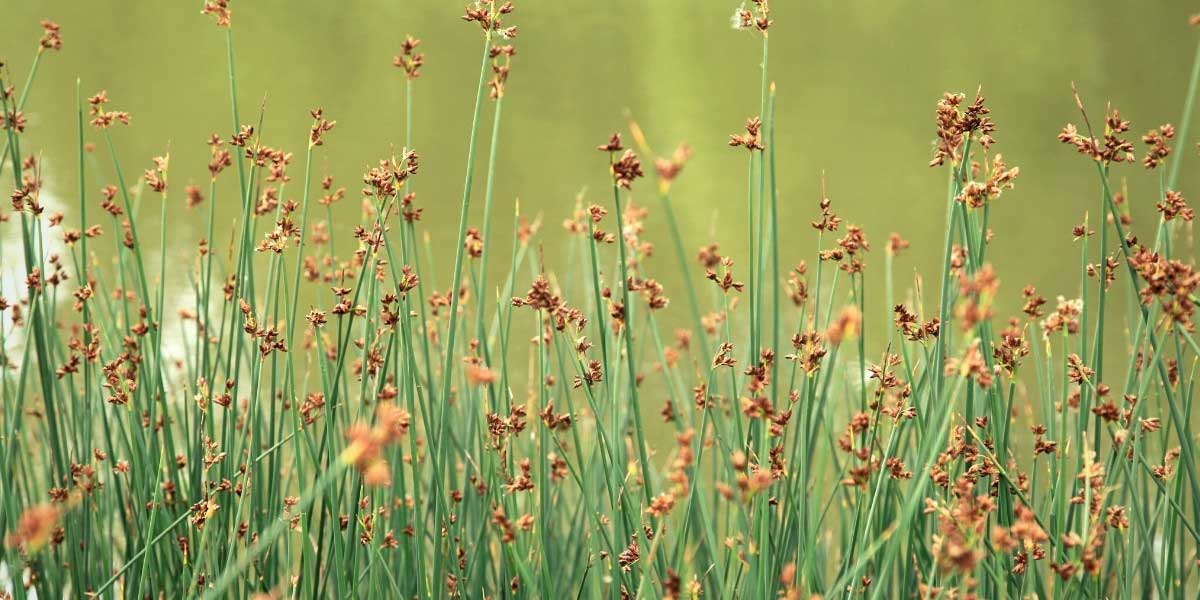
Scirpus lacustris (photo Frank Vincentz)
Maintenance
Whether planted in a pond or on the banks, Scirpus plants require almost no maintenance. Scirpus lacustris and tabernaemontani are very hardy and do not need protection in winter. We simply recommend cutting back the stems to about 10 cm at the end of winter or early spring. This will stimulate growth and allow the plant to renew its stems.
If you grow Scirpus cernuus in a pot, ensure the substrate remains consistently moist. Always keep water in the saucer and add a piece of charcoal to prevent mould growth. In spring and summer, you can add a little fertiliser. If you notice the stems drying out, it means the substrate is too dry or the temperature is too high for the plant (especially if grown indoors). In winter, if possible, place it in a cool but frost-free room, away from radiators and heat sources.
Multiplication
Although it is possible to sow scirpus, this method is rarely used, and we recommend division instead, as it is much easier and quicker.
Dividing Clumps
If you have a scirpus that has been established for several years and has had time to grow and spread a little, don’t hesitate to divide it to obtain several young plants, share them, or relocate them to a new spot. This will help rejuvenate the clumps and give them more space. Carry out this task in spring, around April.
- Remove the scirpus from its pot or dig it up carefully;
- Divide the clump into several sections by loosening the rootstock and cutting it with pruning shears. Each section of rootstock should have a few roots and young tillers;
- Take the opportunity to remove any dead or damaged stems;
- Replant immediately, either on the banks or in the pond.
Association
The Bulrush is perfect for creating a very natural scene on the banks of a pond, pairing it, for example, with reeds (Phragmites australis) and cattails (Typha latifolia). Their tall and lush foliage will effortlessly complement that of the bulrushes. Add brightness with the beautiful variegated foliage of the reed Phragmites australis ‘Variegatus’ and enjoy the opulent and finely cut foliage of ferns, such as Matteuccia struthiopteris or Osmundas. For flowering plants, consider planting on the banks purple loosestrifes, brook thistles (Cirsium rivulare), and meadowsweets. Enjoy the slender foliage and mauve flower spikes of Thalia dealbata, a very elegant aquatic plant! Plant in the pond water lilies (Nymphaea sp.), their elegant flowers will be the centrepiece of this aquatic scene!
For more information and ideas, explore our advice sheets “Choosing aquatic plants for a pond or water feature” and “10 aquatic plants, submerged or floating”.
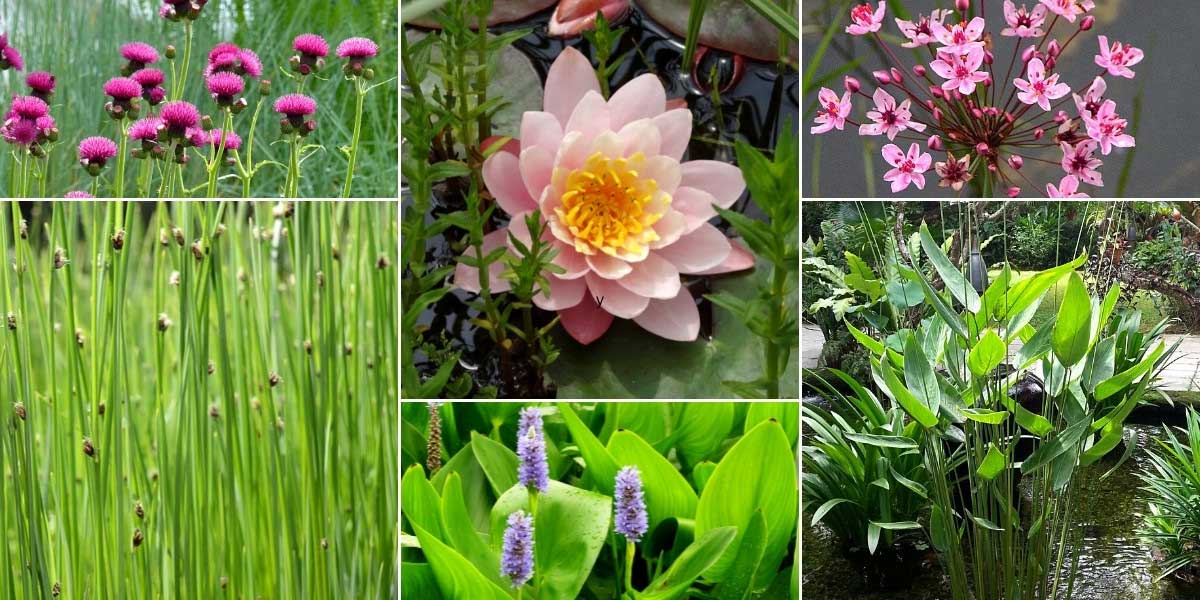
Pair Bulrush with other aquatic or marginal plants. Cirsium rivulare ‘Atropurpureum’, Nymphaea, Butomus umbellatus, Scirpus tabernaemontani, Pontederia cordata, and Thalia dealbata (photo Lip Kee)
You can also create a modern and graphic aquatic scene with bulrush. For this purpose, we particularly recommend Scirpus tabernaemontani ‘Zebrinus’, with its green stems striped with creamy white. Pair it with the variegated foliage of Phalaris arundinacea ‘Picta’, the surprisingly spiralled stems of the rush Juncus effusus ‘Spiralis’, and the tall, very upright stems of horsetails, Equisetum, for a beautiful contrast of shapes! You can also incorporate some flowering plants, such as the graphic umbels of Butomus umbellatus and the small white plumes of the cotton grass, Eriophorum angustifolium.
Also worth reading
- Discover our range of Scirpus
- Our guide «8 aquatic plants for oxygenating ponds or pools»
- Subscribe!
- Contents































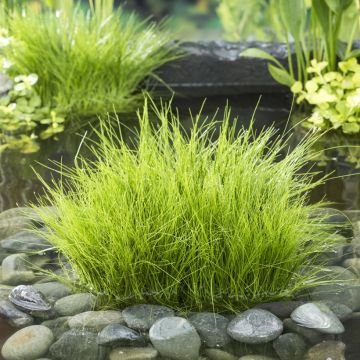
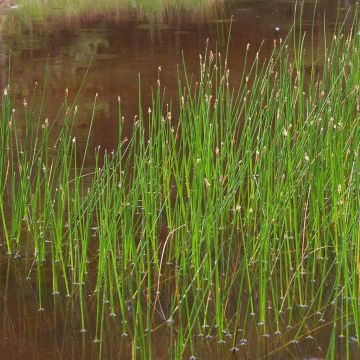

Comments